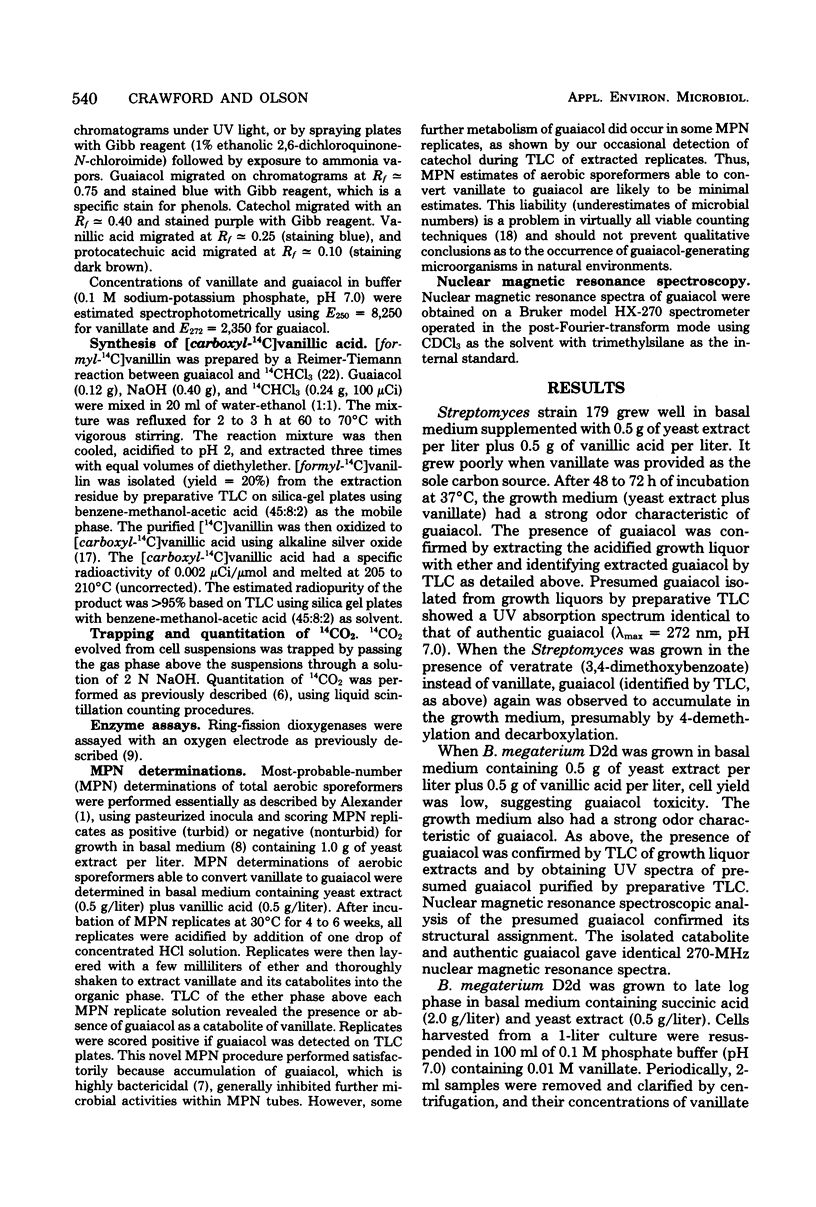Abstract
A novel catabolic transformation of vanillic acid (4-hydroxy-3-methoxybenzoic acid) by microorganisms is reported. Several strains of Bacillus megaterium and a strain of Streptomyces are shown to convert vanillate to guaiacol (o-methoxyphenol) and CO2 by nonoxidative decarboxylation. Use of a modified most-probable-number procedure shows that numerous soils contain countable numbers (10(1) to 10(2) organisms per g of dry soil) of aerobic sporeformers able to convert vanillate to guaiacol. Conversion of vanillate to guaiacol by the microfloras of most-probable-number replicates was used as the criterion for scoring replicates positive or negative. Guaiacol was detected by thin-layer chromatography. These results indicate that the classic separations of catabolic pathways leading to specific ring-fashion substrates such as protocatechuate and catechol are often interconnectable by single enzymatic transformations, usually a decarboxylation.
Full text
PDF




Selected References
These references are in PubMed. This may not be the complete list of references from this article.
- Cain R. B., Bilton R. F., Darrah J. A. The metabolism of aromatic acids by micro-organisms. Metabolic pathways in the fungi. Biochem J. 1968 Aug;108(5):797–828. doi: 10.1042/bj1080797. [DOI] [PMC free article] [PubMed] [Google Scholar]
- Cartwright N. J., Buswell J. A. The separation of vanillate O-demethylase from protocatechuate 3,4-oxygenase by ultracentrifugation. Biochem J. 1967 Nov;105(2):767–770. doi: 10.1042/bj1050767. [DOI] [PMC free article] [PubMed] [Google Scholar]
- Cartwright N. J., Smith A. R. Bacterial attack on phenolic ethers: An enzyme system demethylating vanillic acid. Biochem J. 1967 Mar;102(3):826–841. doi: 10.1042/bj1020826. [DOI] [PMC free article] [PubMed] [Google Scholar]
- Crawford D. L., Crawford R. L. Microbial degradation of lignocellulose: the lignin component. Appl Environ Microbiol. 1976 May;31(5):714–717. doi: 10.1128/aem.31.5.714-717.1976. [DOI] [PMC free article] [PubMed] [Google Scholar]
- Crawford R. L., Kirk T. K., McCoy E. Dissimilation of the lignin model compound veratrylglycerol-beta-(o-methoxyphenyl) ether by Pseudomonas acidovorans: initial transformations. Can J Microbiol. 1975 Apr;21(4):577–579. doi: 10.1139/m75-082. [DOI] [PubMed] [Google Scholar]
- Crawford R. L., McCoy E., Harkin J. M., Kirk T. K., Obst J. R. Degradation of methoxylated benzoic acids by a Nocardia from a lignin-rich environment: significance to lignin degradation and effect of chloro substituents. Appl Microbiol. 1973 Aug;26(2):176–184. doi: 10.1128/am.26.2.176-184.1973. [DOI] [PMC free article] [PubMed] [Google Scholar]
- Crawford R. L. Mutualistic degradation of the lignin model compound veratrylglycerol-beta-(o-methoxyphenyl) ether by bacteria. Can J Microbiol. 1975 Oct;21(10):1654–1657. doi: 10.1139/m75-241. [DOI] [PubMed] [Google Scholar]
- Crawford R. L. Novel pathway for degradation of protocatechuic acid in Bacillus species. J Bacteriol. 1975 Feb;121(2):531–536. doi: 10.1128/jb.121.2.531-536.1975. [DOI] [PMC free article] [PubMed] [Google Scholar]
- Crawford R. L. Pathways of 4-hydroxybenzoate degradation among species of Bacillus. J Bacteriol. 1976 Jul;127(1):204–210. doi: 10.1128/jb.127.1.204-210.1976. [DOI] [PMC free article] [PubMed] [Google Scholar]
- Dagley S. Catabolism of aromatic compounds by micro-organisms. Adv Microb Physiol. 1971;6(0):1–46. doi: 10.1016/s0065-2911(08)60066-1. [DOI] [PubMed] [Google Scholar]
- DeFrank J. J., Ribbons D. W. p-Cymene pathway in Pseudomonas putida: ring cleavage of 2,3-dihydroxy-p-cumate and subsequent reactions. J Bacteriol. 1977 Mar;129(3):1365–1374. doi: 10.1128/jb.129.3.1365-1374.1977. [DOI] [PMC free article] [PubMed] [Google Scholar]
- HENDERSON M. E. The metabolism of aromatic compounds related to lignin by some hyphomycetes and yeast-like fungi of soil. J Gen Microbiol. 1961 Sep;26:155–165. doi: 10.1099/00221287-26-1-155. [DOI] [PubMed] [Google Scholar]
- Kirk T. K., Lorenz L. F. Methoxyhydroquinone, an intermediate of vanillate catabolism by Polyporus dichrous. Appl Microbiol. 1973 Aug;26(2):173–175. doi: 10.1128/am.26.2.173-175.1973. [DOI] [PMC free article] [PubMed] [Google Scholar]
- Toms A., Wood J. M. The degradation of trans-ferulic acid by Pseudomonas acidovorans. Biochemistry. 1970 Jan 20;9(2):337–343. doi: 10.1021/bi00804a021. [DOI] [PubMed] [Google Scholar]


